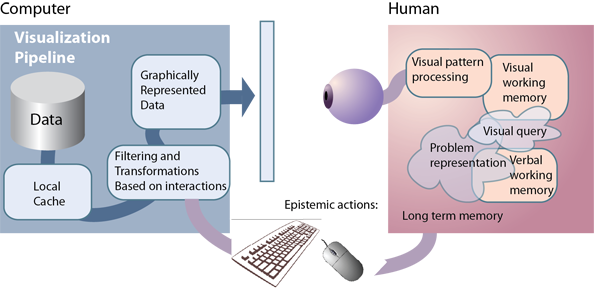|
The Components of a Visual Thinking Design Pattern
A VTDP begins with a statement of the problem it is designed to solve, together with one or more examples. In most cases it will contain a pseudo-code description of the combined cognitive process and this will typically incorporate many the following components. Perceptual and Cognitive Operations These include converting some part of a problem into a visual query, mentally adding both imagery and attributes to a perceived symbol or other feature. Cognitive operations include decisions such as terminating a visual search when an item is found. A key bottleneck in cognitive processing is the capacity of visual working memory, so situations where visual working memory limits can lead to cognitive inefficiently are elucidated, and solutions described. Visual QueriesAn aspect of a problem is cognitively transformed so that progress can be made using a visual pattern search. For example, finding a relationship in a social network diagram will involve visually tracing a line linking two nodes. Visual queries provide a method for reasoning about key problems of data representation. Visual Pattern ProcessingA visual pattern is the target of a visual query. The goal of efficient graphic design is to ensure that data is mapped into graphical form in such a way that all probable visual queries can be efficiently executed. Most complex design problems involve tradeoffs; therefore, the pattern mappings for more frequent or more important visual queries should be more salient. Working Memory LoadWorking memory capacity is assumed to be at most 4 simple patterns or shapes if the patterns are previously unknown. If patterns are well known, a skilled analyst can remember many more as well as more complex patterns. Epistemic ActionsThese are actions designed to seek information. They include mouse movements to select data objects, causing them to reveal more about their attributes, and panning and zooming actions to navigate through a data space. This is a broadening of Kirsh and Magio's [1] initial concept. It goes beyond manipulations of the environment to include actions that do not actually change the environment but are nevertheless executed to gain knowledge. These include eye or head movements to pick up detailed information from different parts of a display [2]. ExternalizingThese are instances where someone saves some knowledge gained, by putting it out into the world, for example, by adding annotations to a visualization, or checking boxes to indicate that certain information is deemed important or irrelevant. Interaction ComputationThis includes all parts of a visual thinking algorithm that are executed in a computer. Of particular relevance to VTDPs are computations that rapidly change how information is displayed. This can be as simple as zooming or changing the range of the data that is displayed because of user interaction. Display BudgetThe display budget is the amount of visual information that can be usefully displayed at a given time. For example, there is no point in displaying a graph with 5000 nodes if very few of them can be visually resolved. The VTDP Virtual MachineWhen thinking about interactive systems, it is useful to consider the simple virtual machine, illustrated in Figure 1. This contains a simple visualization pipeline as well as the key components of perceptual and cognitive processing. Very often, a gain in cognitive efficiency can be achieved by shifting part of the workload from visual working memory by means of simple computations and interactive methods. The basic elements of the visual thinking virtual machine are shown below.
|
